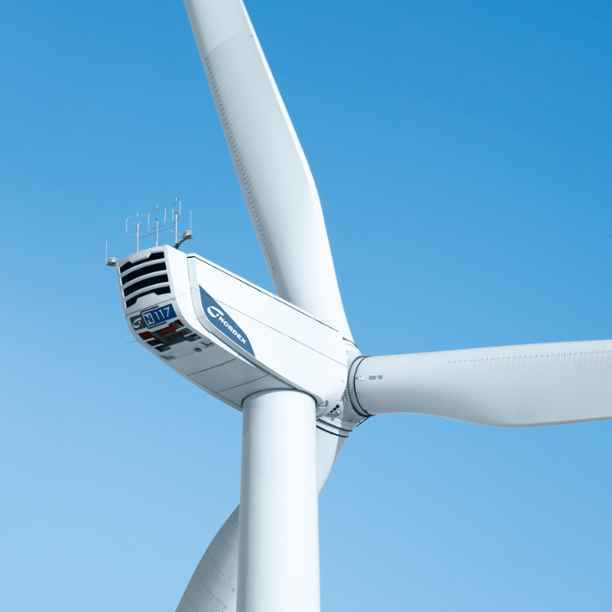Many of Europe's wind and solar farms are at the end of their lifespan after about 25 years. The technology - wind turbines or solar panels - needs renewal. This requires large investments, but it also offers opportunities because there are considerable efficiency gains to be made, so that wind farms, for instance, generate more sustainable energy. This will ultimately accelerate the energy transition.
With more than ten large wind farms in its portfolio, Triodos Energy Transition Europe Fund is a major player in repowering of wind farms. On several large projects, such redevelopment has already begun, usually in a joint venture with a project developer with extensive local experience.

Redeveloping existing sites has advantages over building new parks, Van Beek argues. "All the infrastructure is already there. Building the connection to the energy network is usually a substantial cost item. Moreover, a zoning plan is already in place and in some cases, you can even build on the old foundation. In short, the chances of success are higher."
Repowering offers impact and returns
Van Beek explains that this project development offers more impact and return than when the fund simply takes a stake in an existing wind farm. "We actually create something new with repowering. We make something possible with our investment: extra capacity that provides for the generation of more renewable energy. That is tangible impact."
In doing so, project development also leads to a better return than in a situation where, for example, you must bid against other investors in a tender for participation in an existing wind farm, Van Beek continues. "After all, that participation then goes to the investor who settles for the lowest return. We keep away from that."
Repowering has another advantage. De Ruiter: "Because these are our own farms, we can start preparations at an early stage, before the first spade goes into the ground. That is sensible asset policy. You don't wait until the wind farm reaches the end of its economic life but can take steps in advance. Since these are long-term processes, that is a huge advantage."
A small ecological footprint
Repowering is primarily about increasing production in megawatts, mainly thanks to the deployment of new turbines that are technologically a lot more advanced than the old ones. However, we are also looking at other improvements, confirms De Ruiter. "Our policy is to make the ecological footprint as small as possible. This includes reusing the materials of the turbines you replace. In the recycling of mill blades, for instance, the industry still has steps to take. We want to be at the forefront in that area."
In the province of Zeeland, the Neeltje Jans and Roompotsluis wind farms have already been 'repowered'. For the Willem-Annapolder and Jacoba Haven wind farms, agreements have been made with partners E-Connection and Zeeuwind. Repowering will also further increase the capacity of the large Midlum wind farm in Germany. Van Beek expects the repowering of these farms to double the power generation. A thorough study was also carried out on the impact of the redevelopment on the surrounding ecology, water safety, noise, external safety and tourism. "One outcome of this was that the location of one of the new turbines had to be changed to protect a breeding colony of birds and the migration route of bats."
Battery storage as an accelerator of the energy transition
Renewable sources now supply about 50% of the electricity in the Netherlands, but wind and solar can supply too much energy to the grid at peak generation times, and too little at other times. Tackling grid congestion is therefore another key focus for the fund, Van Beek says. "When rolling out renewable energy, this is still often an inhibiting factor. The stability of the Dutch energy grid, for example, is a growing concern. For companies in particular, the consequences are serious if they have insufficient power available for a while or even structurally. The demand for electricity is growing every year, especially with the electrification of our economy and vehicle fleet.”

Investing in the energy network itself is an obvious solution. However, energy storage at the parks also plays a crucial role in coping with the peaks and troughs in electricity generation. Batteries can therefore no longer be ignored in the (re)development of wind and solar farms. Apart from erecting new turbines, realising energy storage is Triodos Energy Transition Europe Fund's second major investment activity.
Smart behind-the-meter solutions
Businesses can also secure power 'behind the meter' with battery storage on their premises, making them less dependent on the energy grid. Batteries can store self-generated power, allowing companies to cover peak periods in the energy grid. "In the UK and Ireland, we are working in a joint venture with GridBeyond to install batteries at businesses," says Van Beek. "Batteries make the power supply for businesses and households more stable. They also improve the quality of the grid voltage, resulting in fewer outages."
These behind-the-meter solutions do not stop at batteries. Van Beek: “We have extensive experience of generating power with solar panels on company roofs. Companies are also increasingly looking at smarter consumption of electricity. For instance, by tuning your production or charging a fleet of electric vehicles outside busy times on the grid. The latter can be done with smart charging stations. We are involved in several initiatives integrating these behind-the-meter solutions.”
Creative solutions are also possible when redeveloping parks. De Ruiter: "You can make better use of the limited grid capacity and space by putting up a combination of wind turbines, solar panels and batteries. If it is not windy the sun might shine, and if you have little sun, wind can fill the gap. What we also do in repowering is to anticipate future developments well. A good solution now, does not mean it is the right solution for tomorrow."


